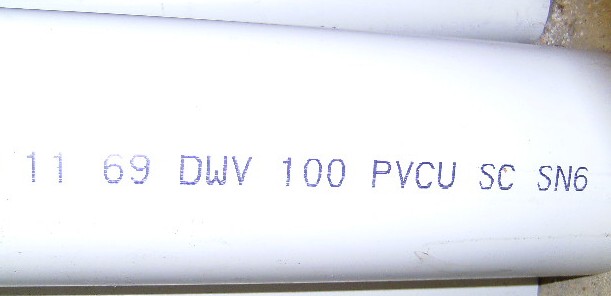It’s important to make sure you are getting the right type of pipes and fittings that will be underground…..you don’t want to be digging up you garden, or paths, in case of blockages.
Pipes
Some plumbers will want to use, and bury, 90 mm diameter rainwater pipes, basically plastic downpipes.
You need to make sure you are getting as a minimum 100 mm PVC pipes rated as DWV.(Stands for Drainage, Waste and Vent).
The reasons are:
-
-
- The 90 mm pipe is thin walled and can be easily deformed once buried. This means you lose capacity without realising it. The DWV is a much thicker and thus stronger pipe.
- Although the increase in pipe diameter is fairly small the flow capacity of the larger pipe is over 40% higher. That makes a difference in storm conditions.
-
This is printed on the pipe every 1m.
Protect Underground Pipes
It’s important to protect your underground pipes.
One of the problems during a new house construction is that concrete tend to fill underground pipes, causing blockage.
A hydraulic impact cutter can remove concrete in drains and sewers.
Other problems include leaking or burst pipes caused by corrosion, tree roots, and collapsed pipes.
Roots tend to grow toward the direction of the water so a loose connecting or weak point in the underground pipes triggers tree roots to wrap around them until they burst.
That’s why the design of the pipe system is crucial to ensure a problem-free plumbing.
They should be away from trees and other structures to avoid these problems.
You can use an experienced plumber to help protect your underground pipes.
A qualified and experienced plumber will detect common leak indicators in the underground pipes and repair them. They’ll test the repair and fill the trench.
Bends
Bend refers to a term for any change or offset of direction in the pipes, which includes elbows.
They’re fabricated as per piping specification requirement.
Elbows come in standard or pre-fabricated and are available off the shelf.
Bends are available in 4 different angles for DFW pipes as follows: 15 degrees, 30 degrees, 45 degrees and 90 degrees.
Although 90 degree bends are available, I would NOT install them underground due to the blockage risk….. If you need a 90 degree change of direction underground:
-
-
- For a drain or a sewer use a junction pit.
- For a charged (pressure) rainwater system use two 45 degree bends with an inspection ‘T’ in the middle.
-

Is it illegal or against the BCA to bury 90mm pvc for a charged system
Not illegal but it doesn’t conform with BCA and Plumbing Regulations…………. But neither do a lot of plumbing installations.
Based on the Plumbing Industries own statistics its likely that there are thousands of non-compliant installations every year. (See this article for an example http://www.smh.com.au/nsw/hidden-report-confirms-gutter-debacle-20110725-1hx55.html )
Brian